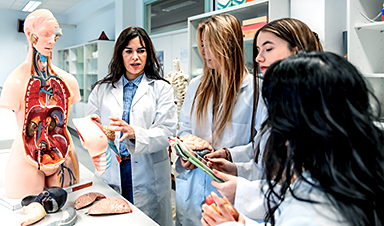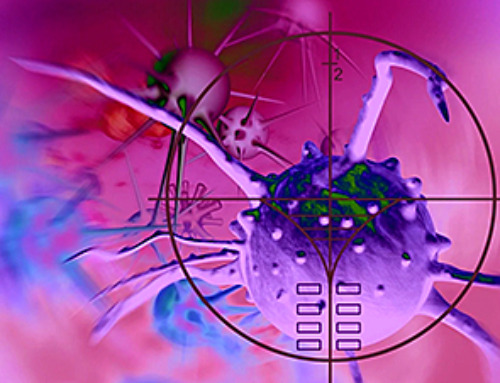Menadione, a vitamin K precursor, shows promise in slowing prostate cancer in mice by disrupting cancer cell survival processes, with potential applications for human treatment and myotubular myopathy therapy.
Prostate cancer is a quiet killer. In most men, it’s treatable. While it’s treatable in many men, some cases prove resistant to all current therapies and become highly aggressive. Researchers at Cold Spring Harbor Laboratory (CSHL) have made a new discovery that could lead to a game-changing solution.
CSHL Professor Lloyd Trotman’s lab has found that the pro-oxidant supplement menadione slows prostate cancer progression in mice. The supplement is a precursor to vitamin K, commonly found in leafy greens. The story begins more than two decades ago.
In 2001, the National Cancer Institute’s SELECT trial sought to determine if an antioxidant vitamin E supplement could successfully treat or prevent prostate cancer. The trial involving 35,000 men was planned to last up to 12 years.

However, after just three years, participants were told to stop taking their supplements. Not only had vitamin E failed to slow or prevent prostate cancer—more men taking the supplement started to get the disease. Seeing these results, Trotman thought, ‘If an antioxidant failed, maybe a pro-oxidant would work.’ His new findings in mice show just that.
How Menadione Targets Cancer Cells
When mice with prostate cancer are given menadione, it messes with the cancer’s survival processes. Trotman’s team has discovered that menadione kills prostate cancer cells by depleting a lipid called PI(3)P, which works like an ID tag. Without it, the cells stop recycling incoming materials and eventually explode.
“It’s like a transport hub, like JFK. If everything that goes in is immediately de-identified, nobody knows where the airplanes should go next. New stuff keeps coming in, and the hub starts to swell. This ultimately leads to the cell bursting,” explains Trotman.
This causes the cancer’s progression to slow significantly in mice. Trotman now hopes to see the experiment translated to pilot studies in human prostate cancer patients:
“Our target group would be men who get biopsies and have an early form of the disease diagnosed. We wonder if they start to take the supplement, whether we would be able to slow that disease down.”
Amazingly, Trotman’s research suggests menadione may also prove effective against myotubular myopathy, a rare condition that prevents muscle growth in infant boys. Those diagnosed rarely live beyond early childhood. Trotman’s lab has found that depleting PI(3)P with menadione can double the lifespan of mice with this condition.
If the results hold up in humans, it would mean that men with prostate cancer can enjoy a better quality of life and more time with their families. It could also mean more precious time for children born with an incurable disease.
Reference: “Dietary pro-oxidant therapy by a vitamin K precursor targets PI 3-kinase VPS34 function” by Manojit M. Swamynathan, Shan Kuang, Kaitlin E. Watrud, Mary R. Doherty, Charlotte Gineste, Grinu Mathew, Grace Q. Gong, Hilary Cox, Eileen Cheng, David Reiss, Jude Kendall, Diya Ghosh, Colleen R. Reczek, Xiang Zhao, Tali Herzka, Saulė Špokaitė, Antoine N. Dessus, Seung Tea Kim, Olaf Klingbeil, Juan Liu, Dawid G. Nowak, Habeeb Alsudani, Tse-Luen Wee, Youngkyu Park, Francesca Minicozzi, Keith Rivera, Ana S. Almeida, Kenneth Chang, Ram P. Chakrabarty, John E. Wilkinson, Phyllis A. Gimotty, Sarah D. Diermeier, Mikala Egeblad, Christopher R. Vakoc, Jason W. Locasale, Navdeep S. Chandel, Tobias Janowitz, James B. Hicks, Michael Wigler, Darryl J. Pappin, Roger L. Williams, Paolo Cifani, David A. Tuveson, Jocelyn Laporte and Lloyd C. Trotman, 25 October 2024, Science.
DOI: 10.1126/science.adk9167
Funding: National Cancer Institute, Pershing Square Sohn Cancer Research Alliance, IC-MedTech, U.S. Department of Defense, Simons Foundation, AstraZeneca UK, Medical Research Council, Robertson Research Fund
News
Most Plastic in the Ocean Is Invisible—And Deadly
Nanoplastics—particles smaller than a human hair—can pass through cell walls and enter the food web. New research suggest 27 million metric tons of nanoplastics are spread across just the top layer of the North [...]
Repurposed drugs could calm the immune system’s response to nanomedicine
An international study led by researchers at the University of Colorado Anschutz Medical Campus has identified a promising strategy to enhance the safety of nanomedicines, advanced therapies often used in cancer and vaccine treatments, [...]
Nano-Enhanced Hydrogel Strategies for Cartilage Repair
A recent article in Engineering describes the development of a protein-based nanocomposite hydrogel designed to deliver two therapeutic agents—dexamethasone (Dex) and kartogenin (KGN)—to support cartilage repair. The hydrogel is engineered to modulate immune responses and promote [...]
New Cancer Drug Blocks Tumors Without Debilitating Side Effects
A new drug targets RAS-PI3Kα pathways without harmful side effects. It was developed using high-performance computing and AI. A new cancer drug candidate, developed through a collaboration between Lawrence Livermore National Laboratory (LLNL), BridgeBio Oncology [...]
Scientists Are Pretty Close to Replicating the First Thing That Ever Lived
For 400 million years, a leading hypothesis claims, Earth was an “RNA World,” meaning that life must’ve first replicated from RNA before the arrival of proteins and DNA. Unfortunately, scientists have failed to find [...]
Why ‘Peniaphobia’ Is Exploding Among Young People (And Why We Should Be Concerned)
An insidious illness is taking hold among a growing proportion of young people. Little known to the general public, peniaphobia—the fear of becoming poor—is gaining ground among teens and young adults. Discover the causes [...]
Team finds flawed data in recent study relevant to coronavirus antiviral development
The COVID pandemic illustrated how urgently we need antiviral medications capable of treating coronavirus infections. To aid this effort, researchers quickly homed in on part of SARS-CoV-2's molecular structure known as the NiRAN domain—an [...]
Drug-Coated Neural Implants Reduce Immune Rejection
Summary: A new study shows that coating neural prosthetic implants with the anti-inflammatory drug dexamethasone helps reduce the body’s immune response and scar tissue formation. This strategy enhances the long-term performance and stability of electrodes [...]
Scientists discover cancer-fighting bacteria that ‘soak up’ forever chemicals in the body
A family of healthy bacteria may help 'soak up' toxic forever chemicals in the body, warding off their cancerous effects. Forever chemicals, also known as PFAS (per- and polyfluoroalkyl substances), are toxic chemicals that [...]
Johns Hopkins Researchers Uncover a New Way To Kill Cancer Cells
A new study reveals that blocking ribosomal RNA production rewires cancer cell behavior and could help treat genetically unstable tumors. Researchers at the Johns Hopkins Kimmel Cancer Center and the Department of Radiation Oncology and Molecular [...]
AI matches doctors in mapping lung tumors for radiation therapy
In radiation therapy, precision can save lives. Oncologists must carefully map the size and location of a tumor before delivering high-dose radiation to destroy cancer cells while sparing healthy tissue. But this process, called [...]
Scientists Finally “See” Key Protein That Controls Inflammation
Researchers used advanced microscopy to uncover important protein structures. For the first time, two important protein structures in the human body are being visualized, thanks in part to cutting-edge technology at the University of [...]
AI tool detects 9 types of dementia from a single brain scan
Mayo Clinic researchers have developed a new artificial intelligence (AI) tool that helps clinicians identify brain activity patterns linked to nine types of dementia, including Alzheimer's disease, using a single, widely available scan—a transformative [...]
Is plastic packaging putting more than just food on your plate?
New research reveals that common food packaging and utensils can shed microscopic plastics into our food, prompting urgent calls for stricter testing and updated regulations to protect public health. Beyond microplastics: The analysis intentionally [...]
Aging Spreads Through the Bloodstream
Summary: New research reveals that aging isn’t just a local cellular process—it can spread throughout the body via the bloodstream. A redox-sensitive protein called ReHMGB1, secreted by senescent cells, was found to trigger aging features [...]
AI and nanomedicine find rare biomarkers for prostrate cancer and atherosclerosis
Imagine a stadium packed with 75,000 fans, all wearing green and white jerseys—except one person in a solid green shirt. Finding that person would be tough. That's how hard it is for scientists to [...]





















